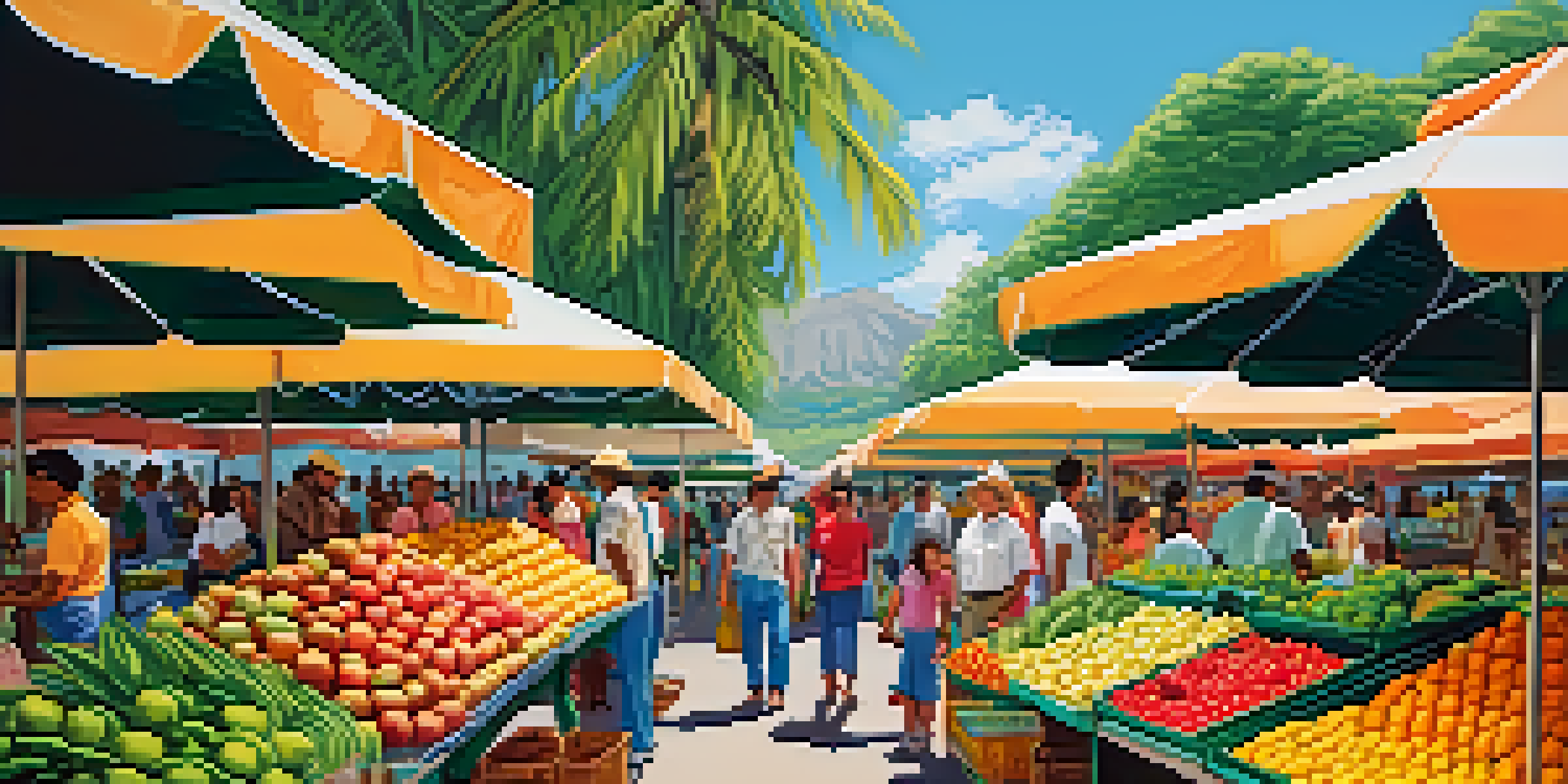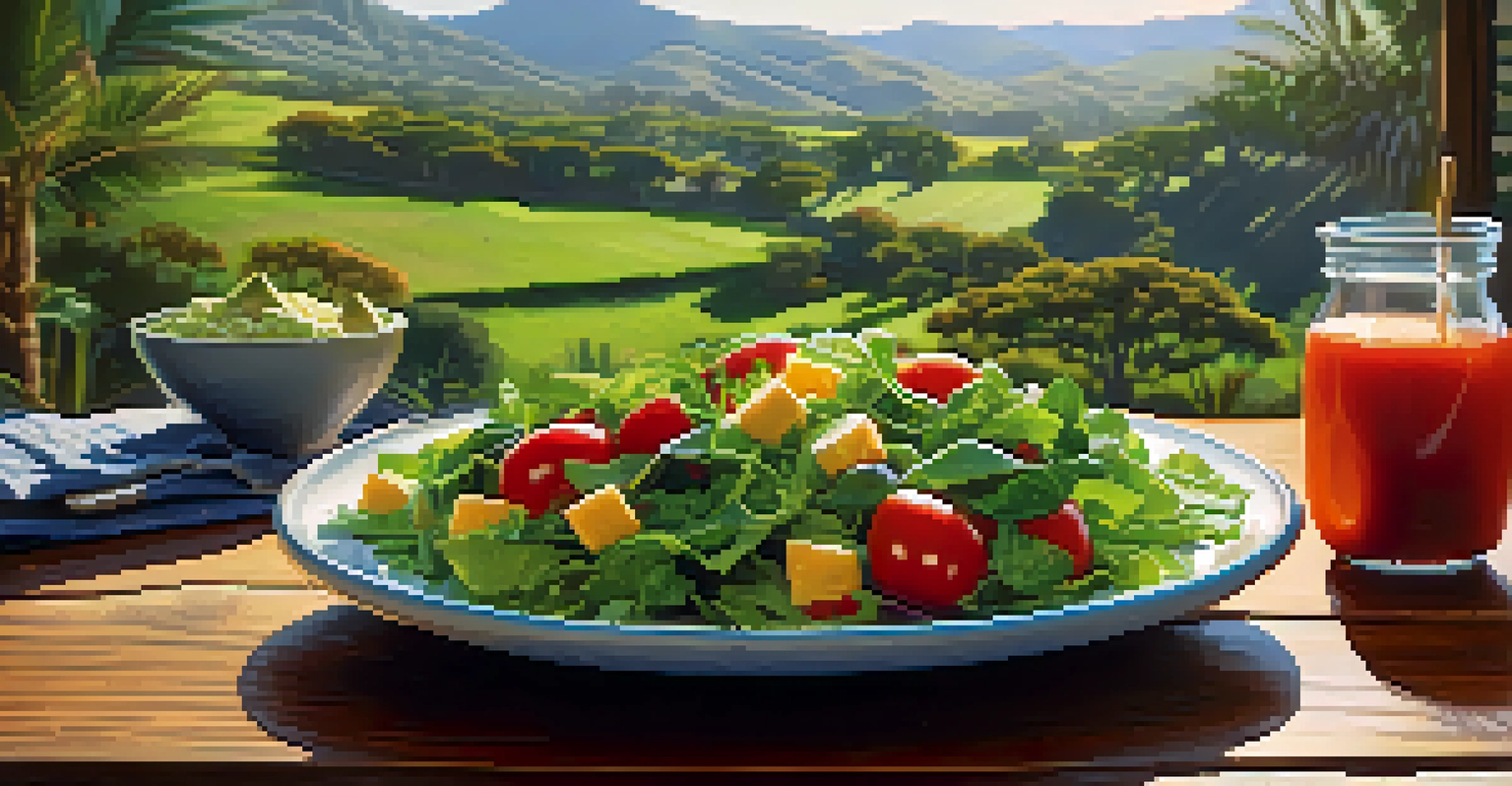From Farm to Table: Hawaii's Sustainable Food Movement

Understanding the Farm to Table Concept in Hawaii
The farm-to-table movement emphasizes sourcing food directly from local farms, ensuring freshness and sustainability. In Hawaii, this concept is deeply rooted in the islands' agricultural traditions, where communities prioritize locally grown produce. By reducing the distance food travels, we not only support local farmers but also minimize our carbon footprint.
Eating locally is not just about food; it's about connecting with your community and the land around you.
In Hawaii, the farm-to-table movement is not just about food; it’s about connecting people with their environment. Imagine biting into a juicy pineapple that was picked just hours ago from a nearby farm. This connection fosters appreciation for the land and encourages more sustainable practices across the islands.
Moreover, this movement highlights the importance of biodiversity in agriculture. Hawaii's unique climate allows for a wide variety of crops, from taro to tropical fruits, promoting a diverse diet that benefits both health and ecosystem balance.
The Role of Local Farmers in Sustainability
Local farmers in Hawaii play a crucial role in the sustainable food movement. These dedicated individuals often utilize organic practices that preserve the land and water resources, ensuring a healthy ecosystem for future generations. Their methods not only combat climate change but also enhance the quality of the food we consume.

For example, many Hawaiian farmers grow crops that are well-suited to the island’s unique environment, reducing the need for synthetic fertilizers and pesticides. By focusing on native plants and traditional farming techniques, they contribute to the preservation of Hawaii's rich agricultural heritage.
Farm-to-Table Boosts Local Economy
The farm-to-table movement in Hawaii connects consumers with local farmers, promoting fresh produce and sustainability.
Additionally, local farmers are increasingly engaging in community-supported agriculture (CSA) programs. This model allows consumers to invest directly in farms, receiving fresh produce in return while fostering a strong sense of community and responsibility toward local food systems.
Impact of Sustainable Practices on Health
Sustainable food practices not only benefit the environment but also have significant health advantages. When you eat locally sourced food, you're more likely to consume fresher, nutrient-rich ingredients. This is particularly important in Hawaii, where the tropical climate yields a wealth of vitamins and minerals essential for a healthy lifestyle.
Sustainable agriculture is a way of life that reflects our values, our commitment to the environment, and our responsibility to future generations.
Moreover, local foods often lack the preservatives and chemicals found in mass-produced items. By choosing farm-fresh produce, residents and visitors alike can enjoy meals that are not only delicious but also promote overall well-being. Think about it: a salad made with freshly harvested greens can be far more nourishing than one that has traveled thousands of miles.
Additionally, the sustainable movement encourages a seasonal eating approach, which means enjoying foods at their peak ripeness. This seasonal diet can lead to improved digestion and a more balanced intake of nutrients, ultimately contributing to better health outcomes.
Building Community Through Sustainable Food
The sustainable food movement in Hawaii fosters a strong sense of community among residents. Local farmers' markets are vibrant hubs where people gather not just to shop, but to connect with their neighbors and learn about the food they eat. These markets often feature workshops, cooking demonstrations, and tasting events that encourage community engagement.
Additionally, many restaurants in Hawaii are embracing the farm-to-table philosophy, partnering with local farmers to create menus that reflect the islands' culinary heritage. Diners can enjoy dishes crafted from locally sourced ingredients, which not only support the economy but also strengthen relationships between producers and consumers.
Sustainable Practices Enhance Health
Eating locally sourced food leads to fresher, nutrient-rich meals that contribute to overall well-being.
As people become more aware of the origins of their food, there’s a growing appreciation for the effort and dedication that goes into sustainable farming. This awareness creates a community that values health, sustainability, and the preservation of Hawaii's unique agricultural landscape.
Challenges Facing Hawaii's Sustainable Food Movement
Despite its many benefits, Hawaii's sustainable food movement faces significant challenges. The islands are often reliant on imported goods due to limited land and resources, making it difficult for local farmers to meet the demand for fresh produce. Additionally, the high cost of living can make it challenging for residents to prioritize locally sourced foods.
Climate change poses another threat, as rising sea levels and changing weather patterns can impact crop yields and soil health. Farmers are adapting by implementing innovative practices and diversifying their crops, but these changes require time and investment. The struggle to sustain local agriculture while facing environmental challenges is a delicate balance.
Moreover, education and awareness about sustainable practices are still growing. Many consumers may not fully understand the importance of supporting local food systems or the impact of their purchasing decisions. Bridging this knowledge gap is essential for the movement's long-term success.
The Future of Sustainable Food in Hawaii
Looking ahead, the future of Hawaii's sustainable food movement is promising. There’s a growing interest among younger generations to learn about agriculture and sustainable practices. Schools and community programs are increasingly incorporating agricultural education, inspiring the next wave of eco-conscious individuals.
Technological advancements also play a role in this movement. Innovative farming techniques, such as vertical farming and aquaponics, are being explored to maximize limited land resources. These methods can help increase food production while minimizing environmental impact.
Community Engagement Through Food
Farmers' markets and farm-to-table restaurants foster community connections and deepen appreciation for sustainable agriculture.
Finally, as more consumers become aware of the benefits of sustainable food, the demand for locally sourced products is likely to rise. This shift could encourage more farmers to adopt sustainable practices, creating a cycle of support that benefits everyone—from the fields to our tables.
How You Can Support Hawaii's Sustainable Food Movement
Supporting Hawaii's sustainable food movement is easier than you might think! Start by visiting local farmers' markets and purchasing fresh produce directly from growers. This not only guarantees you the freshest ingredients but also helps local farmers thrive and encourages sustainable practices.
You can also choose to dine at restaurants that prioritize farm-to-table menus. Many establishments in Hawaii proudly showcase local ingredients, so don’t hesitate to ask your server where the food comes from. By supporting these businesses, you contribute to a community that values sustainability and local agriculture.

Lastly, consider participating in community-supported agriculture (CSA) programs. These initiatives allow you to invest in local farms, receiving a share of their harvest in return. It’s a fantastic way to support sustainable practices while enjoying a variety of seasonal produce right from the source.